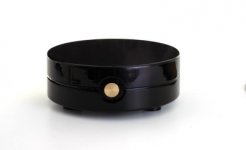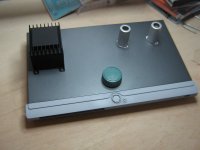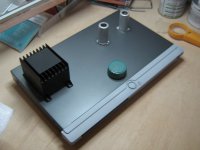Because wood is a nice and WARM material in a sensual way... has been discussed in the "Aesthetics" thread to the end...😀
Also tube amplifiers might be heat generating devices but they ain't stoves or radiators...
Also tube amplifiers might be heat generating devices but they ain't stoves or radiators...
wood and heat sink's? WHAT! EWWWW now that is retarded!
Well, why don't you show us retards how it should be done then?
Perhaps even with something you have designed, that actually works inside....
Magura 🙂
Member
Joined 2002
It's good to know I'm not alone on this issue. Why so much love for wood around here on heat generating equipment like tube amp? 🙄
I wonder when pass labs is going to start putting wood on there amplifiers, PROBABLY LIKE NEVER!
J'
I wonder when pass labs is going to start putting wood on there amplifiers, PROBABLY LIKE NEVER!
Pass Labs is selling to a different market.
Some are attracted to the warm, organic nature of wood, while others are attracted to "machined from solid billet aluminum."
se
Member
Joined 2002
Pass Labs is selling to a different market.
Some are attracted to the warm, organic nature of wood, while others are attracted to "machined from solid billet aluminum."
se
Exactly 🙂
I'm attracted to "machined from solid billet aluminum."
SALAS:
That cabinet is downright beautiful! Where did you find that? Did you craft that?
There is some REAL artistic thought in that creation! Someone got that one right on the nose.
_____________________________________________________________Rick....
That cabinet is downright beautiful! Where did you find that? Did you craft that?
There is some REAL artistic thought in that creation! Someone got that one right on the nose.
_____________________________________________________________Rick....
SALAS:
That cabinet is downright beautiful! Where did you find that? Did you craft that?
There is some REAL artistic thought in that creation! Someone got that one right on the nose.
_____________________________________________________________Rick....
It is not made by Salas, but a member of M.O.A.N 😀
Magura 🙂
How it looks is different tastes & different persuasions. And they say sight is much more pragmatic than hearing, imagine a how it sounds discussion.

SALAS:
That cabinet is downright beautiful! Where did you find that? Did you craft that?
There is some REAL artistic thought in that creation! Someone got that one right on the nose.
_____________________________________________________________Rick....
No I just said I liked it too.🙂 MJL21193 did it both for circuit and box.
Member
Joined 2002
i like!
That's 100% wood (well 99%, and 1% black paint).
The heatsinks are hidden on the backside.
Magura 🙂
Talk would suffice as far as the choice of chassis material goes. Wood is combustible, prone to drying and cracking when subjected to heat (repeated on & off), it doesn't transfer heat much (good for handles if one moves the amp around daily) but there are better materials if insulating is the intent. Some are desiring its surface appearance but if the the system sounds good, the listener would be engulfed in music, not the looks of their amp. It would only add to the distraction. 🙁Well, why don't you show us retards how it should be done then?
Interesting thread, as always.
From here, the poor side of the street, I've found a cheap chinese DVD player that a neighbour throwed out to the garbage. Now it's becoming the outer body of my tube preamplifier.
The knob is from triodeel. All the shitty glossy parts were covered with primer. Under the shields there are 12AU7s.
Bogus Cheapo Design Inc.
From here, the poor side of the street, I've found a cheap chinese DVD player that a neighbour throwed out to the garbage. Now it's becoming the outer body of my tube preamplifier.
The knob is from triodeel. All the shitty glossy parts were covered with primer. Under the shields there are 12AU7s.
Bogus Cheapo Design Inc.
Attachments
Some are desiring its surface appearance but if the the system sounds good, the listener would be engulfed in music, not the looks of their amp. It would only add to the distraction. 🙁
LOL - I must remember that as I butcher the next piece of aluminium so I can shoehorn into a wooden box with 89 and 91 degree corners...
Talk would suffice as far as the choice of chassis material goes. Wood is combustible, prone to drying and cracking when subjected to heat (repeated on & off), it doesn't transfer heat much (good for handles if one moves the amp around daily) but there are better materials if insulating is the intent. Some are desiring its surface appearance but if the the system sounds good, the listener would be engulfed in music, not the looks of their amp. It would only add to the distraction. 🙁
It's fairly obvious, that you haven't got the slightest clue about woodworking.
If used right, wood is not going to change much, if your amp is gonna burn up or not.
Prone to drying, well yes sir, actually people spend a lot of effort to make it dry PRIOR to machining it. After that, very little is going to change, but that naturally takes that you know what you're doing.
Cracking, well not really. Again it takes that you know what you're doing, obviously not your strongest point.
Heat transfer, now why would you wanna transfer heat through the face-plate or the top for that kind of matter? The heat gets out through the heatsinks, not the face-plate.
The chassis I posted a pic of, is by now more than a year old, no cracks or whatever else.
But then again, it was made by somebody whom knows what he is doing, and not an armchair critic.
Next time you wanna tell us all, how much you know about something, at least do both yourself and us a favor, and get your facts right.
Magura 🙂
Some are desiring its surface appearance but if the the system sounds good, the listener would be engulfed in music, not the looks of their amp. It would only add to the distraction. 🙁
Well, if you prefer a ugly amp built of junk ( old radio parts )...I guess this little guy won`t ever distract the listener 😉

This little guy is shielded on the inside with a aluminium plate. 😀
- Status
- Not open for further replies.
- Home
- Amplifiers
- Tubes / Valves
- This happens when you hire a good designer.



